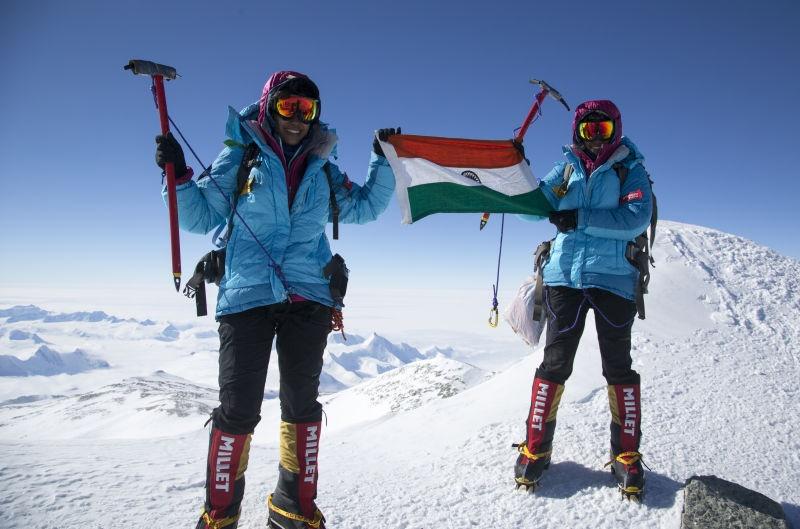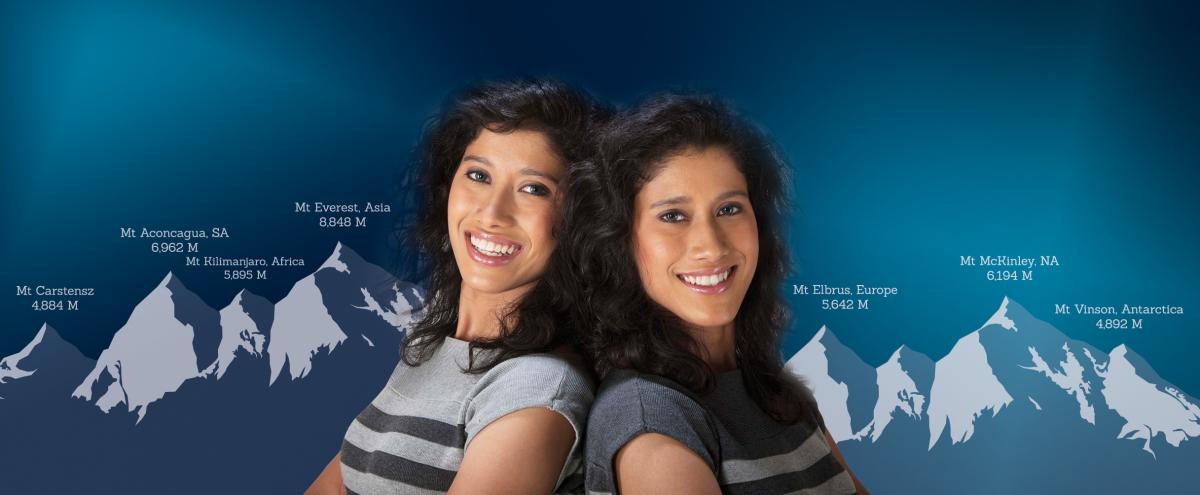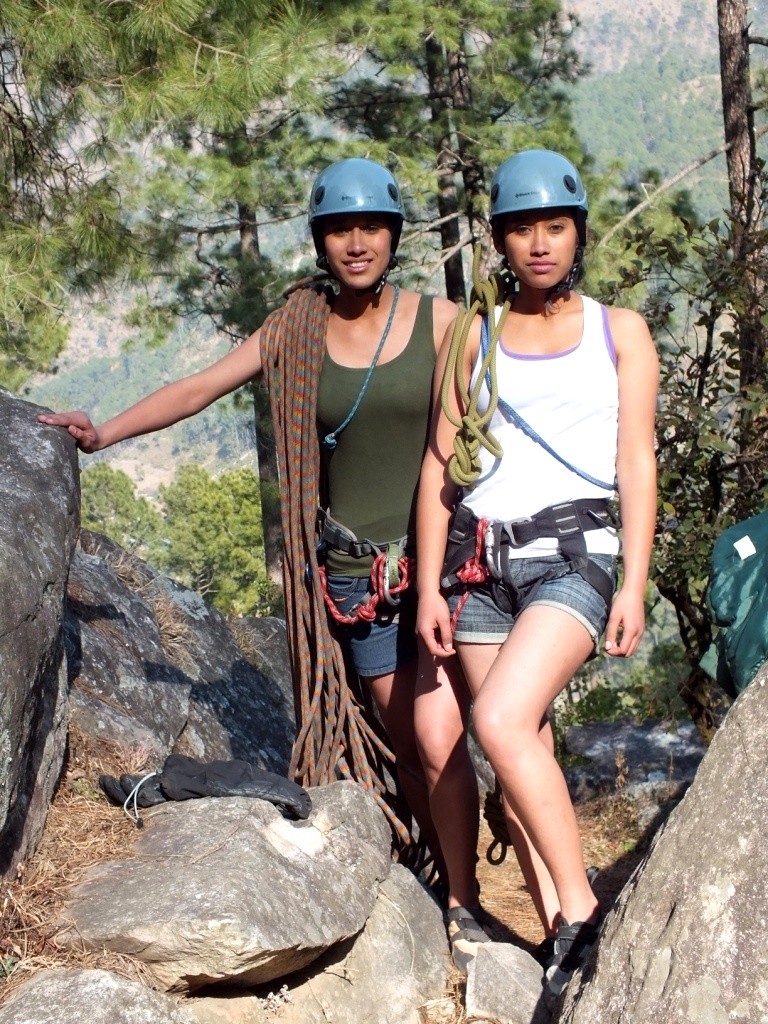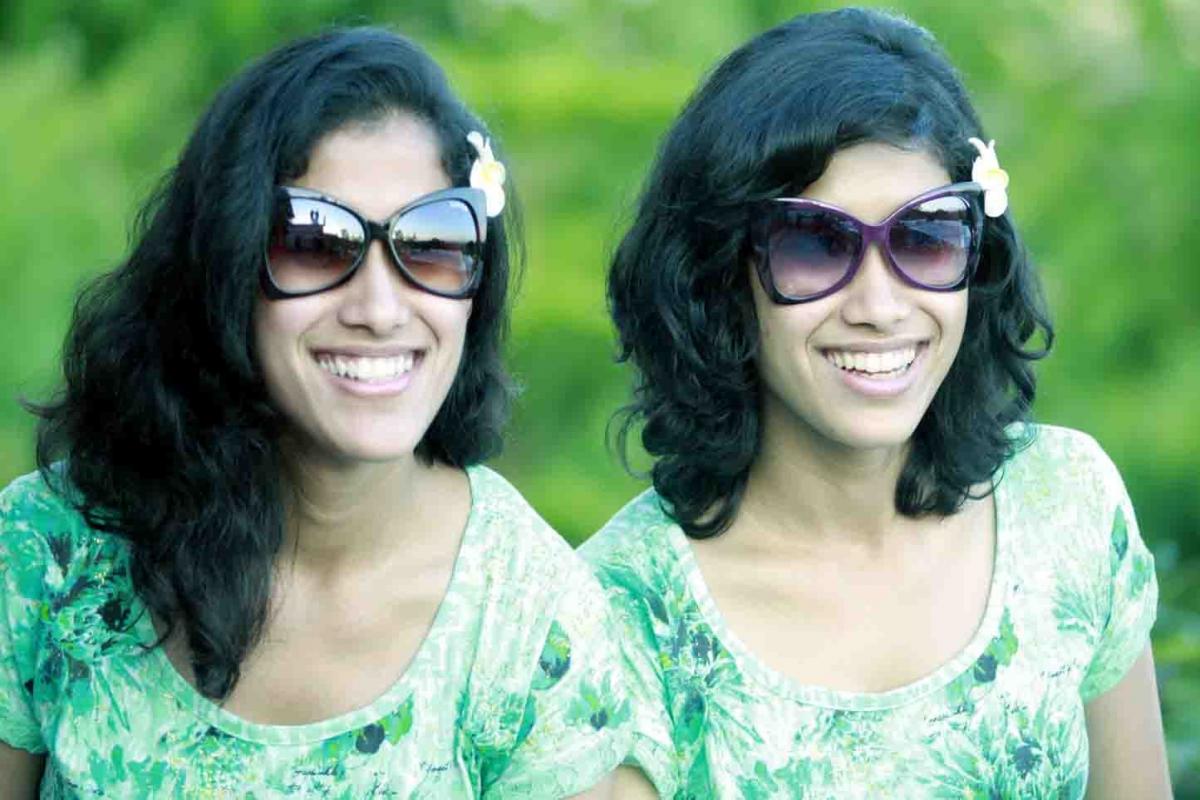
Tashi and Nungshi Malik are women who've overcome the odds to scale the highest mountains—and not just metaphorically. Hailing from a small town in Haryana, India, they've climbed the famed "Seven Summits" mountain peaks in seven continents, and become the first twin sisters to successfully ascend Mt. Everest. Oh, and they've also reached the South Pole on skis.
You know, the usual.
In addition to their astounding outdoor feats, the sisters serve as brand ambassadors for the Beti Bachao (Save Girl Child) program launched by the Uttarakand state government, and are currently studying sport and exercise at the Southern Institute of Technology (SIT) in Invercagill, New Zealand.
We caught up with these mountaineering record-breakers to talk about their craziest experiences in outdoor adventuring, their love/hate sister dynamic, and why they want to inspire other girls and women to aim high—metaphorically and literally.
What are the physical, mental, and emotional challenges involved in mountaineering, especially for women?
Nungshi: It's such a journey for a girl, especially in the context of societies such as ours, which are full of challenges. And the hurdles operate on many levels. Society views mountaineering and outdoor activities as a "boys thing," and girls taking it up is frowned upon. Then there's the attendant high risk to life and limb, which in the case of girls is a much greater concern for parents. Our parents were often cautioned by friends and relatives, "If the girls get injured or lose a limb, who will marry them?" Then, mountaineering is dominated by men, and to travel alone to remote mountains, spending days and weeks together in the company of men, often sharing limited spaces in tents, has its own risks and dangers. Periods are a particular challenge.
Tashi: While attempting Everest, our worst fears came true, as our periods started the evening before we were to leave for the summit bid! With mounting cramps and absolutely no way to change sanitary pads, we labored on for 21 hours to reach the summit and return to the safety of Camp 2 at some 23,000 feet. In our case, we have the additional challenge of poor eyesight and have to use power glasses. These easily get foggy and pose huge problems. In fighting off these hurdles, it is a definite advantage to be together as sisters. There's an inbuilt safety mechanism.
What does climbing mean to you?
Tashi: It is for us a total revelation, a deep inner change. The ascent to the "Roof of the World," or chomolungma as it is called in Tibetan language, has been a spiritual one. We have always viewed our relationship with the mountains with a deep sense of humility, and in our eyes, walking our way up to the summit is synonymous with an inner journey.
Nungshi: Mountain climbing has helped us see the bigger picture of life because we realize how fragile and precious life can be. Our parents never put pressure on our academic performance. Dad, in fact, as a principle never asked us our percentages or marks in school. His rule was simple: If you are happy with your performance, there is no need for me to ask about the result. If you are not happy with it, only you can do something about it.

In a TEDx speech, you said "Mountaineering has taught us that life contracts or expands in proportion to one's courage—the courage to cross the barriers in our minds, to cross the mountains in our hearts." How did you develop this courage? Did you have any role models? Is fear sometimes a part of your mountaineering experience?
Tashi: How did we develop this courage? You ask us! We too fear death. For example, on Everest, we knew that we would encounter bodies of earlier climbers along the way. The worst thing was that we also had to cross the body of a fellow climber from our own season. It is a strange feeling—there you are together, talking, sharing your dreams and sipping tea, and then a few days later, you see that person lying lifeless on your path. During our climbing season, 16 climbers lost their lives, most of whom we had either met or seen occasionally at the Everest basecamp. We also lost one of the sherpas of our group even before the final push for the summit.
The thought that it could have been one of us does cross our mind. But it is these very challenges that instill a high degree of self-awareness and self-confidence.
Nungshi: Serious mountain climbing is definitely very demanding. On the one hand, it is generally an individual and lonely effort (it is you and the mountain!); on the other, there is immense physical pain and impending dangers. Nature is all powerful and when you are attempting the summit of a high mountain, you become aware of your vulnerability and insignificance. The quietness and remoteness add to the sense of loneliness and fear. There are times when evacuation is not possible and the chances of things going wrong are very high. I value the spiritual awakening and heightened self-awareness that these experiences have given me.
Tashi: When we started out for Everest, we had only one role model, Sir Edmund Hillary. By the time we embarked on #mission2for7, we were deeply inspired by Reinhold Messner, a man who is the first person to climb all 14 "above 8,000 meter" peaks without supplementary oxygen. Strangely we haven't really followed women mountaineers. The one lady we surely admire is Junko Tabei, who seems to defy age and goes on moving mountains after mountains. Of course the greatest female alpinist of all time, Austrian Gerlinde Kaltenbrunner, is one mountaineer we are so eager to meet. Gerlinde, are you listening?
You have successfully completed Mission2for7 by conquering seven summits in seven continents. What were the most memorable moments from this experience?
Tashi: Each of the six peaks that we have so far scaled posed different and unique risks and challenges. However, considering all aspects, we would still rate Everest as the most difficult, with Mt. McKinley in Alaska a close second. Everest is the only "above 8,000 meters (26,000 feet)" peak of the "seven summits." Any climb above this altitude has serious life-threatening consequences. Mountaineers refer to the altitudes above this point as the "death zone," where no human body can acclimatize, as the amount of oxygen is insufficient to sustain human life. 
Nungshi: Many deaths in high-altitude mountaineering have been caused by the effects of the death zone, either directly (loss of vital functions) or indirectly (wrong decisions made under stress, physical weakening leading to accidents). An extended stay in the zone without supplementary oxygen will result in deterioration of bodily functions, loss of consciousness, and, ultimately, death. At extreme altitudes, above 7,500 meters (24,600 feet), sleeping becomes very difficult, digesting food is near-impossible, and the risk of High Altitude Pulmonary Eodema or High Altitude C Eodema increases greatly. The experience of living for eight weeks in the company of the shifting Khumbu glacier (the fastest-moving glacier in the world) and the daily thunder of snow avalanches, crossing hundreds-of-feet-wide crevices on shaking ladders, and finally negotiating the dreaded "death zone," cannot be adequately described in words. In brief, it was a life-changing experience in every sense of the word.
What was your worst climbing experience to date?
Tashi: Well, one of the most interesting, freakish, and nerve-wracking experiences we can think of is that of Indonesia's highest peak, the Mt.Carstensz pyramid, which is located in a remote island of west Papua. We reached the basecamp after a week-long trek through rain forests—20 hours non-stop in the rain—and negotiated deep mud pools and mossy tree trunks with an umbrella on one hand and a walking stick on the other. Also, there were our enemies, mosquitos—responsible for 40% of the declined expedition. One night, we decided to eat inside our tent due to heavy rainfall, instead of going to the kitchen tent. We switched on our headlamps and started munching, when all of a sudden hundreds of insects and bugs surrounded our tent looking for a possible inlet. We were damned!
After successfully summiting the peak the following day, we had to head back to camp 2. We were there with a friend, Samina, who had climbed Everest with us last year. On our way back, we came across a river with a fast water current (owing to heavy rains that occurred for a week) and there was a log on which we had to cross over, but it was very slippery. Tashi avoided the mossy log, jumped across, and managed. Samina imitated Tashi's jump, but slipped and fell into the water. She was unconscious within seconds. I jumped in, flinging away my rucksack, and helped Tashi pull her out of the water. It took us approximately four minutes to get her out, splash some water on her face, and resuscitate her. That day, Tashi and I were left with so many unanswerable questions like,"What would the consequences be if she drowned? What if she never came back? What would the media from our nations portray this as?"
That is one experience we'll never forget.
In what ways are you similar and in what ways are you different? How do you complement each other during mountaineering?
Nungshi: Over the years, Tashi has generally acquired psychological dominance over me. She can always get away with her demands, and even if I do know that I am physically slightly stronger (with a two kilogram weight advantage too!), I mentally lose out to her. We do get physical sometimes, and often the outcome is bruise marks and tears, with parents having to separate us.
Then again, twinship leads to huge synergy in mountaineering. We both always shared the same passion for climbing the mountains. Luckily, being twins, it was easy for us to accept challenges and opportunities to "tread less frequented trails in life." It's hard to see ourselves as totally separate from our "other half" because we enjoy being twins and having a continual companion and mentor. Twinship is something not many people understand. We are best buddies, and on a mountain it's very important to have someone you can count on. The trust we have and the bond we share has taken us this far. At times when I am giving up, my twin acts like my left hand and helps me cope.
Tashi: We are often the worst enemies, just as we are best friends. Mom often fears that if such vicious fights were to ever occur during a dangerous climbing expedition, we might push each other off the summit!
Nungshi: With our achievements and the dangers we've faced, we've become even more conscious of our identity as twins. This has bonded us in ways that very few two persons are bonded.

Can you tell us about the experience of entering the South Pole on skis last December? How was the lighting and weather—and did you see penguins?
Nungshi: Oh, it was absolutely incredible! In student days, we used to imagine what it would be like just to stand at the bottom of the world. And to reach there on skis? I don't think we can describe the feeling in words. Coming from a society where millions of girls are not even treated as offspring, and many are killed before birth, for us this journey was like a victory march on behalf of the Indian girl child.
Tashi: We had just completed the grueling week-long climb of Mt. Vinson, the highest peak in Antarctica, and immediately switched to the ski expedition. Energy levels had dipped and we had lost several kilos each. December and January, summer time in Antarctica, sees average temperatures of -25 degrees. Within a few minutes of our exposure to the cold, a thick layer of ice around our buff would form, even reaching our eyelids. For 360 degrees, we could see nothing but an endless expanse of massive ice sheet. Also, sometimes due to bad weather and close proximity to the South Pole, our compass wouldn't show the exact direction. And as our goggles used to get frosted, it was often a big challenge even to see ahead!
Things were getting really difficult and there were moments when we seriously feared that we wouldn't make it to the South Pole. After seven days of skiing, when we finally saw a "black point" in the white landscape, which is the famous station "Amundsen and Scot," it all felt so surreal.
And yes, we saw the cutest creatures of this remotest, most desolate and cold continent—the penguins! These were the emperor penguins, and we wished we could take one home. One fellow climber from Nepal, while trying to get close for a photo, got a nasty poke in her face by an overzealous penguin who thought she was threatening its roost.
You have been appointed brand ambassador for the Beti Bachao (Save Girl Child) campaign in Uttarakhand. How did you get this opportunity, and how do you plan to better the future for girls in India?
Tashi: When we set out to climb Mt. Everest, it was intended to be our final and only climb. After refusing to give us permission to climb the mountain for over two years, our mom acquiesced on one condition: "Success or not, this is your final chance and no more of it again." God seems to have other plans for us, though. Our success was historic as the world's first female twins to climb the mountain, and so was the mass adulation that followed. Two months at the Everest basecamp, including the successful summit, elevated our thinking and inspiration to a whole new level, and we heard this voice within saying, "You must use your passion and your accomplishments to inspire other girls to dream big and achieve, and inspire parents with daughters to give equal opportunities to girls to realize their full human potential."
Nungshi: Immediately post-Everest, we strategized on getting mom's continued approval for #mission2for7 with the appeal that if we succeed, we would inspire millions of girls worldwide, especially in our country, and that there cannot be a bigger fulfillment than to know how useful one is for the larger good. Mom too was inspired by our spate of successes and gave a reluctant nod to continue on our journey. Quite frankly, if we had not been driven by the cause of the girl child, even if we had achieved what we have, it just wouldn't have given us the same degree of joy and fulfillment. Big things happen when body, mind, and spirit are unified for a larger purpose.
Tashi: We want to show that girls can compete on equal footing with men, even in areas traditionally seen as "men's forte." And through this, we want to shatter some of the stereotypes about girls.
Through our achievements and the subsequent media interest, we want to spread the message of gender equality and help fight against female feticide. We deliver gender-related talks at schools and social forums to directly appeal to parents and stakeholders to change their "angle of vision." We also plan to design T-shirts, coffee mugs, calendars, and other utility souvenirs with gender themes to spread awareness and pride in the girl child.
We will use our personal website and blogs to focus attention on this issue of extreme urgency and relevance for the good of our people and country. It is simple: India cannot realize its full potential as long as its girls and women cannot realize theirs!
